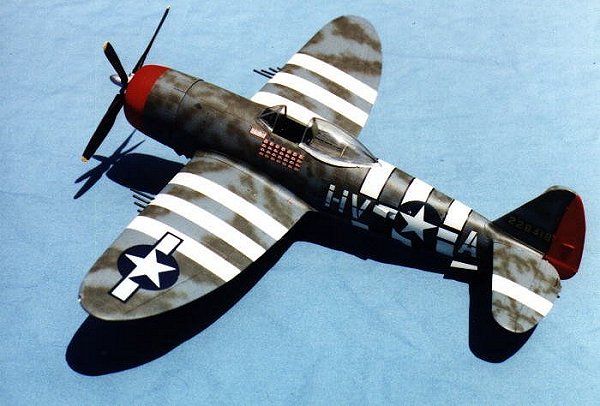
Kit : P-47D "THUNDERBOLT"
Scale: 1/48
Price: MSRP $32.00 (shop for mail order bargains)
Manufacturer: Hasegawa
Kit No: JT-41
Media: Injection-molded plastic
Decals: two different aircraft of the 9th AF
Accuracy: excellent
Overall: "A".
Reviewed By: Thomas McKelvey Cleaver (THE AERONUT)

For an airplane as important as the P-47 was, I don't think it's been well-served by the kit manufacturers. That changed last year with Hasegawa's release of the late-model bubbletop P-47D. This kit has everything in it a modeller needs to do the P-47D-25 to -30 models, and the P-47M. It has both the Hamilton-Standard hydraulic prop blades and the Curtiss-Electric paddle blades. There is a separate fin extension for the later models, and the underwing pylons are separate moldings. This is particularly nice when doing a 56th Fighter Group P-47, as they kept pylons off most of their D's, and all of the M's. Check your references when deciding what model you're making, as these items are what visually distinguish the various versions from each other.
One thing I really liked was the canopy. At first, I thought the windscreen was too small, after doing the old Monogram kit and the Academy P-47N. A check with Roger Freeman's book "Thunderbolt," with its excellent and accurate drawings, showed me that finally someone had done the thing correctly! I've complained about the lack of detail in the cockpits Japanese kit manufacturers provide, but for once, Hasegawa has provided a cockpit that is entirely acceptable. For those demons-for-accuracy types, there is a very nice True Details resin cockpit available, and I recommend it if you think you need it. I put photo-etch seatbelts in the kit cockpit and everything looks just fine. Overall fit is the standard we have come to expect from the Japanese kit-makers and I didn't use any putty.
To me, the one place Hasegawa has been falling down recently is their decals, and this kit is no exception. The decals for the national markings and squadron markings are too translucent, though all the little stencils are just fine. Fortunately, both Aeromaster and SuperScale have been busy producing really wonderful aftermarket decals for the Thunderbolt, both P-47D's and P-47M's, so you have a wide choice of individual aircraft to model.
I wanted to do Gabby Gabreski's last P-47, which he crashed in while strafing a field at Coblenz when his prop hit a rise in the ground. This presented some difficulty, as no one has as yet done this aircraft in the aftermarket sheets. I was lucky to have kept an old sheet from the Monogram kit, which provided the serial number, squadron codes and kill markings. The national insignias came from Aeromaster's sheet of stars and bars. This is a difficult aircraft to reproduce. There are only two photographs I am aware of that are of any help, and if you don't know what you're looking at they are of no help. The one taken from the airplane's 10 o'clock as the pilot does a run-up is most useful. You can see the larger size of the underwing insignia, that it's on both wings, and that the airplane does not use underwing pylons. Past that, though, things get confusing, due to the fact that this was the period when the 56th Fighter Group started camouflaging their aircraft in very non-standard ways. At this time they were still going for actual camouflage, not the individual squadron decoration their '"camouflage schemes" became with the P-47M. The aircraft mostly used RAF Ocean Grey and Dark Green uppers, with Sea Grey Medium lower surfaces (there are instances of Sea Grey medium and Dark Sea Grey or Ocean Grey uppers, which became standard for the 63rd FS with the "M").
The problem past that is that no two aircraft were done the same. Look at a photo of Dave Schilling's plane and you see an RAF-style camouflage, although the green areas are applied with a freehand spray. Gabby's airplane is more problematic. Fortunately, I had once met him at an AFAA convention where I asked about the airplane. He said he'd asked for it to be painted "Luftwaffe Style, " with blotches of green mottle over grey. If you look at that photo with this information, you can see this clearly. I used an "RAF-style" overall pattern (which is what the painters would have been familiar with) done "Luftwaffe-style."
Another sticking point is the D-Day invasion stripes. It looks in the photo as if the black underwing stripes do not carry over onto the upper surface, and a close examination that part of the fuselage stripes that are visible gives the impression there are no black stripes on the upper surface there, either, merely thin black outlines of the white stripes. According to Gabreski, "those stripes compromised camouflage." He had the black removed from the upper surfaces, though he kept the white. In this, he was a month ahead of the rest of the allied air forces, which began removing D-Day stripes from aircraft upper surfaces in early July. You can do the airplane with standard stripes, since he did carry them for a week, but if you're doing the airplane at the end of its career, the scheme in the accompanying photograph is likely as right as anyone's going to get.
My overall impression of this kit is a solid "A." I'm going to do another one as Witold Lanowski's P-47M with the dark purplish-black upper surfaces. I look forward to Hasegawa bringing out a "razorback," and hope it won't be as long as it was between them bringing out the Bf-109G-2 (1992) and the Bf-109G-6 (last month). The kit is definitely worth even the MSRP, and makes an excellent addition to your collection.